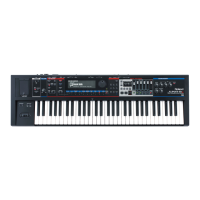75
Overview
Appendix
USB Memory
Song Player
Digital Recorder
Synthesizer
Selecting Sounds Perform. Functions Editing/Eects Other Settings
Rec/Play/Edit Eects Rhythm Pattern
78: SYMPATHETIC RESONANCE
On an acoustic piano, holding down the damper pedal allows other strings to resonate
in sympathy with the notes you play, creating rich and spacious resonances. This eect
simulates these sympathetic resonances.
L in
R in
L out
R out
Sym. Resonance
3-Band
EQ
3-Band
Parameter Value Explanation
Depth # 0–127 Depth of the eect
Damper # 0–127
Depth to which the damper
pedal is pressed (controls the
resonant sound)
Pre LPF 16–15000 Hz, BYPASS
Frequency of the lter that cuts
the high-frequency content of
the input sound (BYPASS: no cut)
Pre HPF BYPASS, 16–15000 Hz
Frequency of the lter that cuts
the low-frequency content of the
input sound (BYPASS: no cut)
Peaking Freq 200–8000 Hz
Frequency of the lter that
boosts/ cuts a specic frequency
region of the input sound
Peaking Gain -15–+15 dB
Amount of boost/cut produced
by the lter at the specied
frequency region of the input
sound
Peaking Q 0.5, 1.0, 2.0, 4.0, 8.0
Width of the frequency region
boosted/cut by the ’Peaking
Gain’ parameter (larger values
make the region narrower)
HF Damp 16–15000 Hz, BYPASS
Frequency at which the
high-frequency content of the
resonant sound will be cut
(BYPASS: no cut)
LF Damp BYPASS, 16–15000 Hz
Frequency at which the
low-frequency content of the
resonant sound will be cut
(BYPASS: no cut)
Lid 1–6
This simulates the actual changes
in sound that occur when the
lid of a grand piano is set at
dierent heights.
EQ Low Freq 200, 400 Hz Frequency of the low-range EQ
EQ Low Gain -15–+15 dB Amount of low-range boost/cut
EQ Mid Freq 200–8000 Hz Frequency of the midrange EQ
EQ Mid Gain -15–+15 dB Amount of midrange boost/cut
EQ Mid Q 0.5, 1.0, 2.0, 4.0, 8.0
Width of midrange (larger values
make the region narrower)
EQ High Freq 2000, 4000, 8000 Hz Frequency of the high-range EQ
EQ High Gain -15–+15 dB Amount of high-range boost/cut
Level 0–127 Output Level
79: VOCODER
L in
MIC
INPUT
L out
R out
Mic Sens
Synth Level
Vocoder
Level
Parameter Value Explanation
Mic Sens # 0–127
Input sensitivity of the
microphone
Synth Level # 0–127 Input level of the instrument
Mic Mix # 0–127
Amount of microphone audio
added to the output of the
vocoder
Level 0–127
Volume level after passing
through the vocoder

